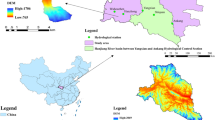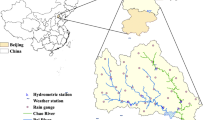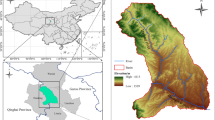Abstract
A GIS-based distributed soil and water assessment tools (SWAT) model was used to simulate the runoff, sediment yield and the load of the non-point source pollution in the Heihe River basin, which is a tributary and main water supply source of the Yellow River. It is a typical stockbreeding area, and its industry and agriculture are not well developed. The main pollution source of the Heihe River was livestock related non-point source pollution. With GIS and remote sensing techniques, a database of non-point source pollution in the Heihe River basin was established. The SWAT model was parameterized for this area. The pollution load and transportation rules such as nitrogen were illustrated. After several years of hard work, the situations of point source pollution were more and more accurate. This paper provided an effective way to assess and calculate the pollution load in the wide agriculture area in China. With the help of historical data formulated parameters, the non-point source load and the theory of pollution load distribution were illustrated about the Heihe River basin. In 2000, the soluble N load in this area was 1.06 × 106 kg. By the simulation, the main pollution sources were in the south east of the basin, where the pasturing areas located in the south-east of Ruoergai County and in north of the Hongyuan County.





Similar content being viewed by others
References
Allred B, Haan CT (1996) Small watershed monthly hydrologic modeling system. Users Manual, Biosystems and Agricultural Engineering Department, Oklahoma State University, Stillwater, Oklahoma, USA
Arnold JG, Allen PM (1999) Automated methods for estimating baseflow and groundwater recharge from stream flow records. J Am Water Resour Assoc 35(2):411–424
Arnold JG, Srinivasan R, Muttiah RS et al (1998) Large area hydrologic modelling and assessment part 1: model development. J Am Water Resour Assoc 34(1):73–89
Bagnold RA (1977) Bedload transport in natural rivers. Water Resour Res 13(2):303–312
Grizzetti B, Bouraoui F, De Marsily G (2005) Modelling nitrogen pressure in river basins: a comparison between statistical approach and the physically-based SWAT model. Phys Chem Earth 30:508–517
Hendry K, Cragg-Hine D, O’Grady M et al (2003) Management of habitat for rehabilitation and enhancement of salmonid stocks. Fish Res 62(5):171–192
Maître Véronique, Cosandey Anne-Claude, Desagher Eric et al (2003) Effectiveness of groundwater nitrate removal in a river riparian area: the importance of hydrogeological conditions. J Hydrol 278(7):76–93
Nash JE, Suttcliffe JV (1970) River flow forecasting through conceptual models, part I. A discussion of principles. J Hydrol 10(3):282–290
Park Seok S, Na Yumee, UchrinChristopher G. (2003) An oxygen equivalent model for water quality dynamics in a macrophyte dominated river. Ecol Modell 168(10):1–12
Santhi C, Arnold JG, Williams JR et al (2001) Validation of the SWAT model on large river basin with point and non point sources. J Am Water Resour Assoc 37(5):1169–1188
USDA-SCS (1972). National engineering handbook, hydrology sect 4, chap 4–10. US Dept. of Agriculture, Soil conservation service, Washington
Whitehead PG, Johnes PJ, Butterfield D (2002) Steady state and dynamic modelling of nitrogen in the River Kennet: impacts of land use change since the 1930s. Sci Total Environ 23(1):417–434
Williams JR (1969) Flood routing with variable travel time or variable storage coefficients. Trans ASAE 12(1):100–103
Williams JR (1975) Sediment routing for agricultural watersheds. Water Resour Bull 11(5):965–974
Williams JR, Laseur WV (1976) Water yield model using SCS curve numbers. J Hydraulics Div ASCE 102:1241–1253
Acknowledgments
The study was supported by the authors thank Dr. Yiguo Han from the Stockholm Environment Institute, Sweden, for providing detailed advice that contributes to improvements and refinement in the paper.
Author information
Authors and Affiliations
Corresponding author
Rights and permissions
About this article
Cite this article
Cheng, H., Ouyang, W., Hao, F. et al. The non-point source pollution in livestock-breeding areas of the Heihe River basin in Yellow River. Stoch Environ Res Ris Assess 21, 213–221 (2007). https://doi.org/10.1007/s00477-006-0057-2
Published:
Issue Date:
DOI: https://doi.org/10.1007/s00477-006-0057-2




